Which foods to eat (and what to avoid)
While experts focus less on individual foods than on an overall pattern of healthy eating, some foods are clearly beneficial and others should be minimized. In general, aim to eat foods high in vitamins, minerals, and other nutrients but lower in calories.
Some nutrients found in many foods show benefit for cancer risk or survival. Fiber is linked to better survival (postmenopausal breast, ovarian) and lower risk of colorectal cancer. Plant lignans are linked to lower cancer risk (breast and colorectal in women, and lung) and better survival (postmenopausal breast cancer). Many nutrients are linked to better body terrainthe internal conditions of your body, including nutritional status, fitness, blood sugar balance, hormone balance, inflammation, and more.
Full details of the evidence: How can Eating Well help you? What the research says › and other pages as linked. Also see Expert recommendations › and Optimizing Your Body Terrain ›
Eat and drink more of these foods
Vegetables and fruits
Many vegetables and fruits are linked to lower risk of cancer or better survival and other outcomes.
Cruciferous vegetables
Cauliflower, broccoli, kale, collards, kohlrabi, Brussels sprouts, cabbage, bok choi, and others
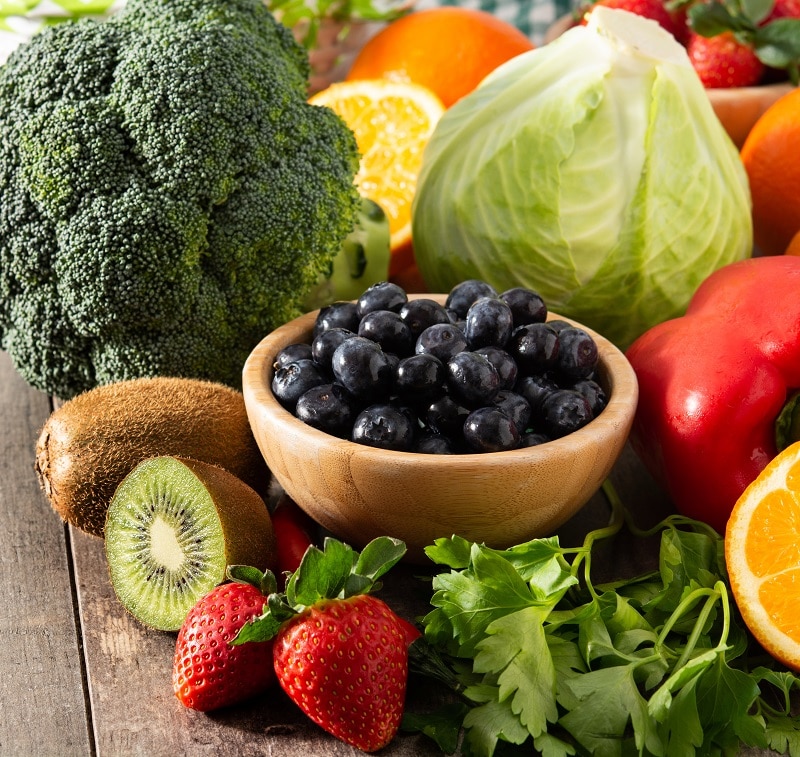
Nutrient highlights: source of fiber, plant lignans and other nutrients linked to lower cancer risk (breast and colorectal in women, and lung) and better survival (breast)
Body terrainthe internal conditions of your body, including nutritional status, fitness, blood sugar balance, hormone balance, inflammation and more connection: promote a healthy gut microbiome
Cancer connections:
- Linked to less prostate cancer progression
- Linked to lower risk of breast cancer recurrence
Orange, red, or deep yellow vegetables and fruits
Carrots, squash, mango, cantaloupe, sweet potatoes, tomatoes, and more
Body terrain connections:
- Better blood sugar and insulin balance
- A good source of anti-inflammatory carotenoids
Cancer connections:
- Lower risk of prostate and head and neck cancer
- Better survival of metastatic breast cancer
Chili peppers containing capsaicin
Cancer connection: lower cancer mortality among people eating these regularly
Blueberries
Nutrient highlights: a source of plant lignans linked to lower cancer risk (breast and colorectal in women, and lung) and better survival (breast)
Body terrain connections:
- Anti-inflammatory
- Antioxidant
- Promote balance in bleeding and coagulation
Pomegranate juice or extract
Cancer connection: linked to longer PSA doubling time (prostate cancer)
Alliums
Garlic, onions, shallots, scallions, and leeks
Body terrain connections:
- Anti-inflammatory
- Antioxidant
Quercetin
Foods high in quercetin include apples, black or green tea, onions, red grapes or wine, cherries, raspberries, citrus fruits, and broccoli
Body terrain connection: anti-inflammatory
Healthy proteins
Legumes such as dried beans, lentils, split peas, chickpeas, and flaxseed
Nutrient highlights: a good source of protein, fiber, vitamins, and minerals
Body terrain connections:
- Better blood glucose and insulin levels
- Antioxidant
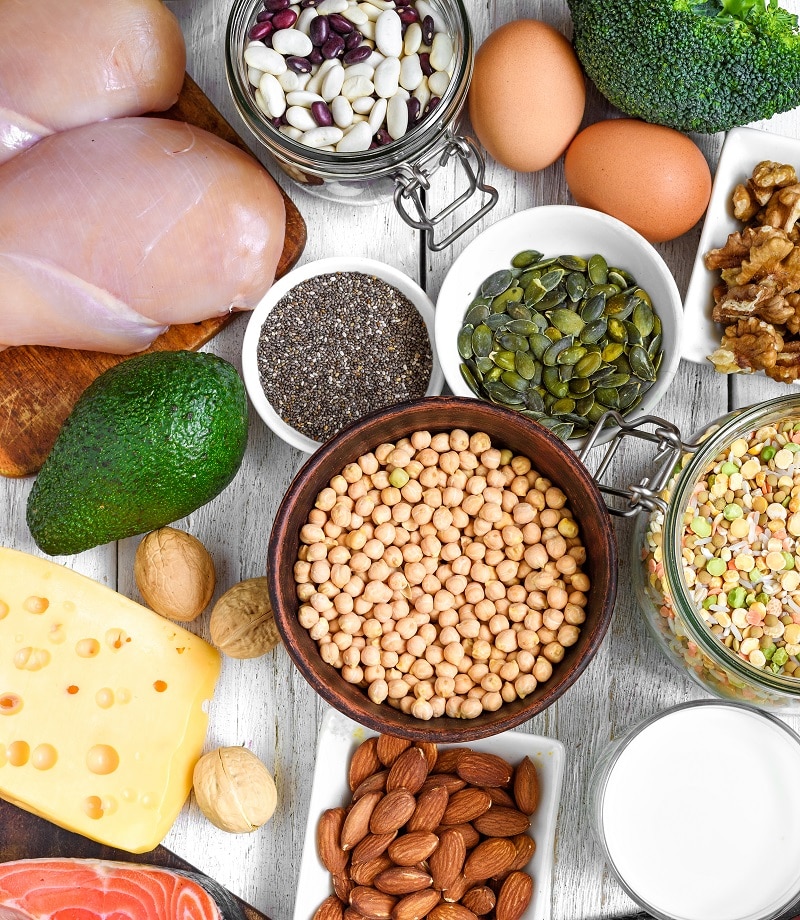
Flaxseed
Nutrient highlights: a good source of plant lignans and other phytoestrogens
Cancer connections of plant lignans and other phytoestrogens:
Cancer connection: lower risk of cancer (prostate)
- Linked to lower risk of lung cancer and of breast and colorectal cancer in women
- Linked to better survival (breast cancer)
Soy foods
Cancer connection: better breast cancer survival and lower risk of recurrence
Note: Soy supplements do not bring the same benefits as soy foods.
Nuts
Nutrient highlights: a good source of of protein, healthy fat, fiber, and inositol hexaphosphate, linked to better blood glucose and insulin levels
Body terrain connection: anti-inflammatory
Cancer connection: lower risk of colorectal cancer and recurrence, and better survival
Animal proteins with higher omega-3 to omega-6 ratios
These include wild-caught salmon, mackerel, or sardines, and high omega-3 eggs.
Body terrain connection: anti-inflammatory
Cancer connections:
- Lower colorectal cancer risk
- Better survival of head and neck and ovarian cancer
Caution: higher risk of prostate cancer or recurrence among people eating eggs
Whole grains
Nutrient highlights:
- A good source of fiber, B vitamins (thiamin, riboflavin, niacin and folate), minerals (iron, magnesium and selenium), and plant lignans
- Relatively low glycemic indexan indication of the ability of a food to raise blood sugar, in a value from zero (not at all) to 100 (pure glucose); high-GI foods are digested quickly and release glucose rapidly into the bloodstream, while low-GI foods release glucose slowly and steadily into the bloodstream
Body terrain connection: promote a healthy microbiome
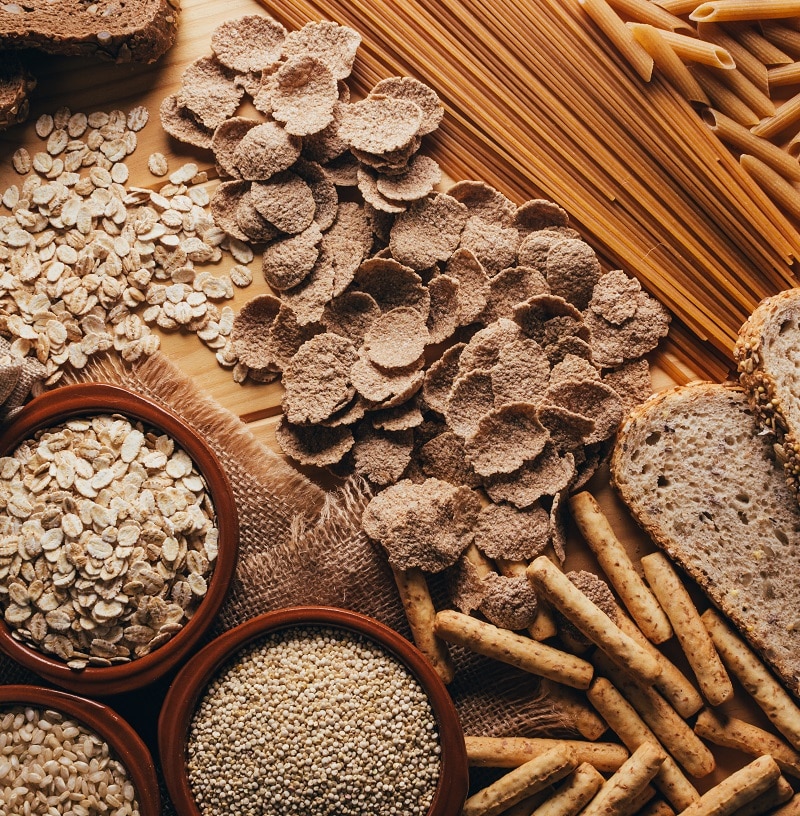
Cancer connections:
- Better survival of head and neck cancer
- Lower risk of colorectal cancer
- Lower risk of breast cancer recurrence
Side effect connection: fewer gastrointestinal symptoms, especially constipation
Healthy fats
Polyunsaturated fatty acids (PUFAs) can be either omega-3s or omega-6s. Both promote health, but aim for a higher proportion of omega-3s to omega-6s.
Health-promoting omega-3 fats
Olive oil, nut oils, and fish high in omega-3 fatty acids
Body terrain connection: anti-inflammatory
Cancer connection: lower risk of colorectal and other digestive cancers, breast, skin, and overall cancer
Side effect connections:
- Linked to better sleep quality
- Linked to less fatigue
Helpful link
Omega-6 fatty acids
Polyunsaturated fats from safflower oil, sunflower oil, corn oil, soybean oil, and sunflower seeds
Nutrient highlights: a better choice than saturated fats from animals, such as butter or lard
Cautions:
- Slightly higher risk of cancer among people who eat higher levels (skin cancer)
- Hydrogenated polyunsaturated fats (trans-fats) are not a healthy choice (see below)
Helpful link
Mushrooms
Nutrient highlights:
- Very low in fat
- A source of fiber and vitamin D ›
Body terrain connections:
- Anti-inflammatory
- Promote immune function
- Antioxidant
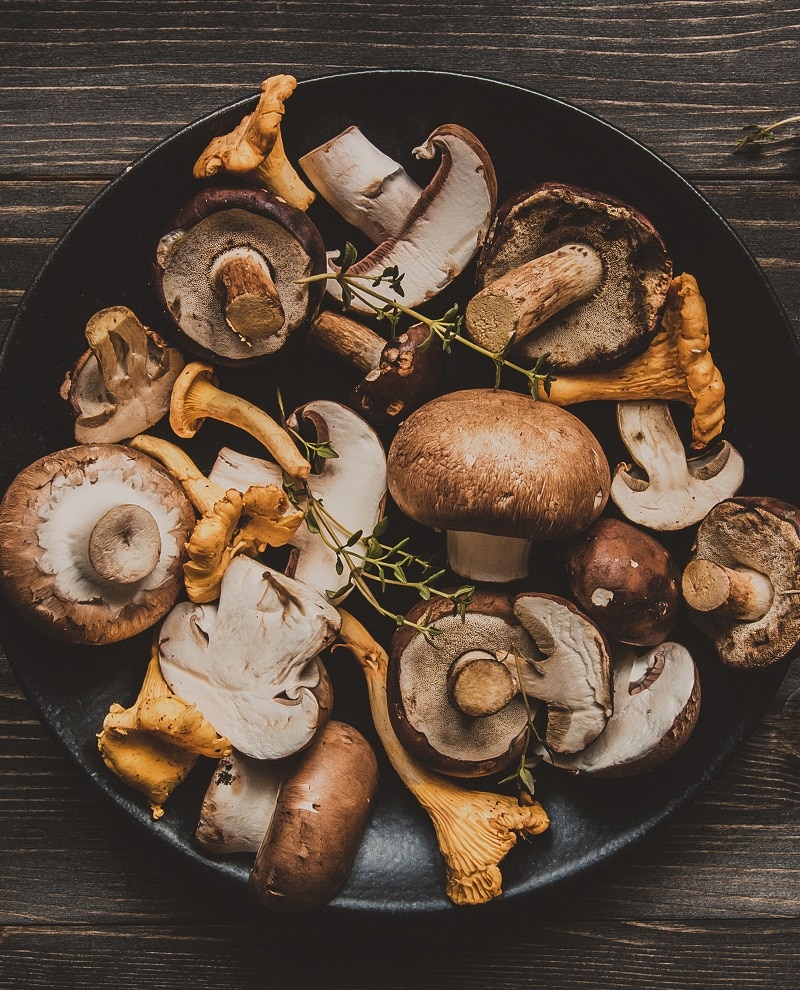
Cancer connection: lower risk of cancer as a whole and breast cancer
While some varieties of medicinal mushrooms are not considered edible, maitake and shiitake are.
Helpful links
Fermented foods
Probiotic yogurt (unsweetened and with live cultures), kefir, tempeh, natto, kombucha, miso, kimchi, sauerkraut, cultured cheese, and more
Body terrain connections:
- Anti-inflammatory
- Promote a healthy microbiome
Cancer connection: lower risk of many types of cancer
Caution: higher risk of estrogen receptor-negative tumors among people eating higher levels of yogurt and cottage/ricotta cheese

Also see Probiotics and Prebiotics ›
Helpful link
Beverages
Water
Body terrain connections:
- Promotes digestion, hormone balance, immune system function, inflammation and other body terrain factors
- Necessary to flush out toxic substances
Side effect connections:
- Averts unpleasant and even dangerous symptoms of dehydration that could lead to treatment delays
- Linked to less severe side effects of cancer treatment, such as nausea, weakness, constipation, and fatigue

Helpful link
Green tea
Body terrain connections:
- Lower body weight
- Lower fasting blood sugar
- Anti-inflammatory
Cancer connections:
- Lower risk of breast cancer diagnosis or recurrence
- Lower risk of several types of cancer
Cautions:
- Higher risk of esophageal, pancreatic, or urinary tract cancers, plus cancer as a whole among people with higher consumption
- Avoid caffeine if you’re at risk of dehydration or anxiety.
Coffee
Cancer connections:
- Better breast cancer survival and outcomes
- Lower risk of cancer as a whole and colorectal cancer
Cautions:
- Irritating to the esophagus, avoid if you’re at risk of esophagitisinflammation of the esophagus from chemotherapy or radiation treatment to the chest
- Avoid caffeine if you’re at risk of or experiencing dehydration or anxiety.
Chef and CancerChoices Senior Clinical Consultant Laura Pole, RN, MSN, OCNS, talks about eating well to make your body less hospitable to cancer, principles of healthy food selection, and more.
Play videoEat and drink less of these foods
Unhealthy fats
Saturated fats
Found in butter, ghee, suet, lard, coconut oil, and palm oil, plus fatty cuts of meat, sausages, bacon, cured meats like salami, chorizo and pancetta, and cheese
Cancer connection: higher risk of cancer mortality and ovarian cancer
Trans-fatty acids
Found in most shortening, fried food, margarine, microwave popcorn, and many baked goods, although some manufacturers have reduced trans-fats in recent years; check labels and avoid foods containing partially hydrogenated oils or listing trans-fats in the nutrient label
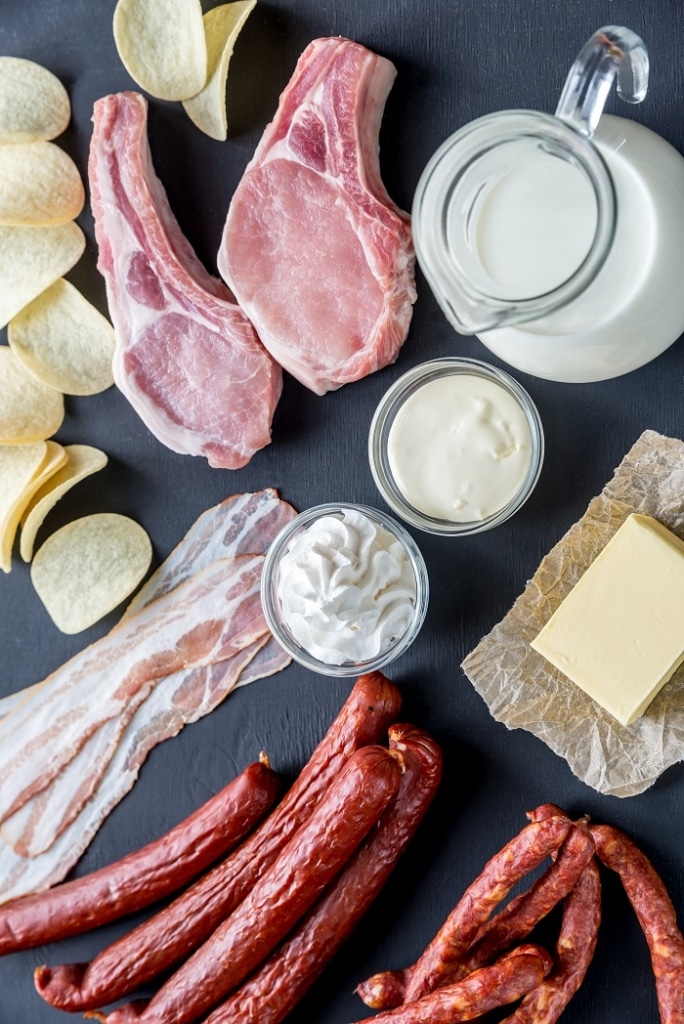
Cancer connection: higher risk of prostate, colorectal, and postmenopausal breast cancer
Less healthy proteins
Red meat
Nutrient concerns: a source of substances linked to increased cancer risk, such as heme1Fiorito V, Chiabrando D, Petrillo S, Bertino F, Tolosano E. The multifaceted role of heme in cancer. Frontiers in Oncology. 2020 Jan 15;9:1540. and sialic acid N-glycolylneuraminic acid2Samraj AN, Pearce OM et al. A red meat-derived glycan promotes inflammation and cancer progression. Proceedings of the National Academy of Sciences U S A. 2015 Jan 13;112(2):542-7.
Body terrain connection: promotes inflammation
Cancer connections:
- Higher risk of colorectal, esophageal, or prostate cancer
- Classified as a Group 2A carcinogen (probably carcinogenic to humans) by the World Health Organization
Processed meats
Cured meats such as bacon or deli meats, hot dogs, salted meats, or smoked meats
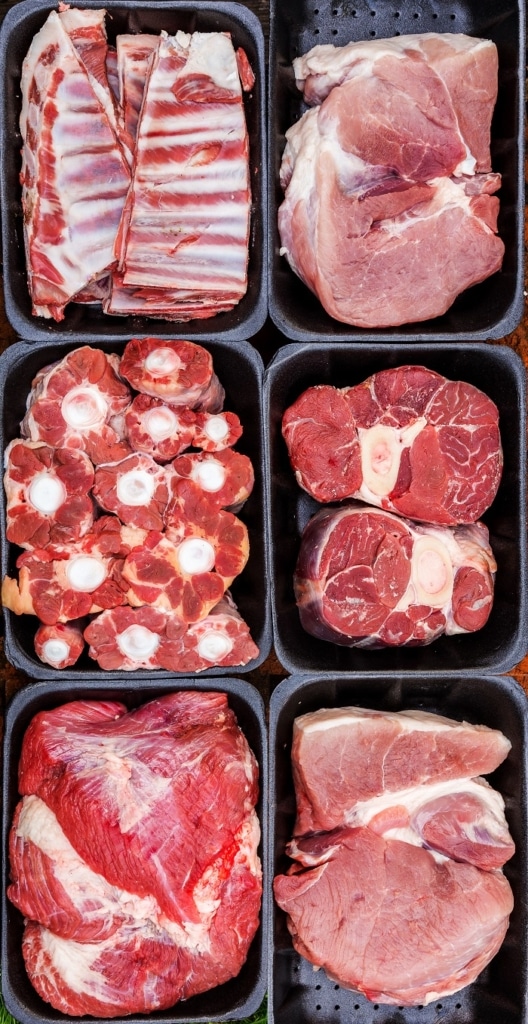
Nutrient concerns: a source of nitrites and/or nitrates, which are listed as probable carcinogens
Cancer connections:
- Higher risk of colorectal, stomach, esophageal, and prostate cancer
- Classified as a Group 2A carcinogen (probably carcinogenic to humans) by the World Health Organization
Sugars and refined grains
Refined sugar or grain products:
- White bread, pasta, cakes and cookies
- Sweetened drinks
- Sugar, honey, and other sweeteners
- Fruit drinks
- White potatoes
- White flour
- White rice

Nutrient concerns:
- High glycemic loada number that estimates how much a food will raise a person's blood sugar level when eaten or glycemic indexan indication of the ability of a food to raise blood sugar, in a value from zero (not at all) to 100 (pure glucose); high-GI foods are digested quickly and release glucose rapidly into the bloodstream, while low-GI foods release glucose slowly and steadily into the bloodstream
- Low in fiber
Body terrain connections:
- Inflammatory
- Promotes worse blood sugar and insulin levels, which are linked to diabetes and metabolic syndrome, which are risk factors for cancer and poorer survival
Cancer connections:
- Linked to worse ovarian cancer survival
- Promotes the growth of some types of cancer cells
Beverages
Drink these in moderation or not at all.
Alcohol
Cancer connection: higher risk of several types of cancers
Side effect connection: higher risk of dehydration

Beverages containing caffeine
Cancer connection: higher risk of esophageal cancer
Side effect connections:
- Increased symptoms of anxiety and stress
- Higher risk of sleep disruption
- Higher risk of dehydration
Cook to reduce toxic chemicals
Some food preparation methods are better than others when it comes to risk of cancer.
Cook meat slowly and at lower temperatures
High-heat cooking of meat can create carcinogens, such as heterocyclic amines and polycyclic aromatic hydrocarbons (PAHs).3Rock CL, Thomson C et al. American Cancer Society guideline for diet and physical activity for cancer prevention. CA: A Cancer Journal for Clinicians. 2020;10.3322/caac.21591. When muscle meat—including beef, pork, fish, or poultry—is cooked by pan frying or grilling directly over an open flame, these chemicals can form. Smoking meat or fish also creates PAHs that cling to the food.4National Cancer Institute. Chemicals in Meat Cooked at High Temperatures and Cancer Risk. July 11, 2017. Viewed April 4, 2018.
See Creating a Healing Environment › for more about the effects of these chemicals on your health and their connection to cancer.
Cooking with lower-temperature methods such as these reduces the formation of harmful chemicals:5Science of Cooking. Science of Slow Cooking. Viewed January 27, 2022.
- Steaming
- Braising
- Poaching
- Stewing
- Roasting
If you grill meat, these techniques can reduce the formation of harmful chemicals:6American Institute for Cancer Research. Guide to Healthy Grilling. May 1, 2014. Viewed January 27, 2022.
- Marinate meat
- Precook larger cuts
- Use lean cuts
- Cut meat into smaller portions and mix with vegetables

Helpful links
Bake, grill, or broil only to a golden brown
When vegetables containing the amino acid asparagine are heated to high temperatures in the presence of certain sugars, a harmful chemical called acrylamide is produced. “The major food sources of acrylamide are French fries and potato chips; crackers, bread, and cookies; breakfast cereals; canned black olives; prune juice; and coffee.”7National Cancer Institute. Acrylamide and Cancer Risk. December 5, 2017. Viewed January 27, 2022. However, the National Cancer Institute notes that most people are exposed to substantially more acrylamide from tobacco smoke than from food.
To reduce your food exposure to acrylamide, use the “Golden Rule”: When grilling, baking or broiling, cook the food to no more than light golden color, while also being mindful of safety. Meats, including poultry and fish, plus eggs need to achieve specific temperatures for safe eating.
Helpful link
Eating for a healthy microbiome
Foods that nourish a healthy microbiome are recommended for most people.
Fermented foods such as yogurt, kefir, miso, sauerkraut, and kombucha may help replenish the gut with healthy microorganisms known as probiotics. See Probiotics and Prebiotics ›
How Eating Well relates to other practices and habits
Eating Well’s connections to Managing Stress
Stress, anxiety, depressive symptoms, and food choices are all related. Interventions to improve food choices may possibly reduce depressive symptoms and stress. The reverse—that reducing depressive symptoms and stress may improve food choices—might also be true.
Eating Well’s connections to Creating a Healing Environment
Foods are sometimes contaminated with chemicals during production or processing.
Some cooking methods can create harmful exposures, such as charring and cooking with high heat.
Some food packaging or storage containers can contaminate food with harmful chemicals.
Foods can be a source of viruses and bacteria.
Eating Well’s connections to Sharing Love and Support
For many people, sharing food preparation and meals—making them social activities—makes them more pleasurable and may help a person with cancer enjoy eating even when their appetite is low. Eating food in pleasant company may also improve digestion and absorption of nutrients.
Diet as an alternative approach to cancer treatment or risk
Diet is one of the most frequent practices people seek as a complement or alternative to conventional treatments. Anticancer diets come and go over the years, many inciting what we call “diet wars”—attacks and defenses of various approaches. Many of the diets have become casualties, lacking evidence of effect or with evidence of no effect or even harm. Some diets are one part of an alternative therapy regimen that may also include coffee enemas and a host of nutritional supplements, as well as other components.
Dozens or even hundreds of diets are available, promising outcomes that may include weight loss, muscle gain, greater energy, detoxification, philosophical or spiritual purity, disease prevention, and even cure. Information, misinformation and bad advice about diet and cancer are all around us, and you—the person with cancer—are caught in the crossfire. To help you sort this out, we summarize many of the more popular diets in our reviews of diets and metabolic therapies.
Mediterranean diet: closely aligned with the diets that experts recommend, this approach focuses on fruits, vegetables, whole grains, legumesa class of vegetables that includes beans, peas, and lentils, and olive oil.
Ketogenic diet: By altering the metabolism of cancer cells, this diet is used to treat certain types of cancer that often don’t respond to other therapies, such as brain cancers. It is not considered a cancer-preventive diet.
Gonzalez Protocol™: This therapy uses freeze-dried pork pancreas, supplements, an individualized diet, and coffee enemas to alter cancer metabolism and inhibit growth. Evidence for improving treatment outcomes is either preliminary or weak.
Gerson regimen: This diet-based therapy regimen targets cancer cell metabolism; it includes a specific diet, supplements, and coffee enemas. Reviews of evidence regarding this approach have not found sufficient evidence of benefit as an adjuvant to other cancer therapies or as a cure.
Other diets:
- Alkaline diet: The American Institute for Cancer Research has concluded that the acidity or alkalinity of foods is not important, but some oncologists find that acidosis is associated with impaired immunity, reduced glutathione and reduced insulin sensitivity—all body terrain factors connected to cancer. The alkalinity of foods can contribute to acidosis: “A diet rich in fruits and vegetables and low in animal protein and sodium chloride [salt] reduces acid load.”13Pizzorno J. Acidosis: an old idea validated by new research. Integrative Medicine (Encinitas). 2015 Feb;14(1):8-12.
- Intermittent fasting: Regularly restricting or eliminating food for spans of several hours or longer can lower insulin resistance, improve your response to chemotherapy, reduce some side effects of cancer treatments and may reduce your risk of recurrence.
- Living foods diet (raw foods diet): A 2014 review did not find clinical evidence supporting its use in cancer patients.
- Macrobiotic diet: This approach based on a traditional Japanese diet has been supported by a few reports of people claiming remarkable reversal of their cancer, but evidence to date does not support the use of this diet for cancer risk reduction, survival or quality of life.
- Paleolithic (Paleo) diet: Higher adherence with this diet is associated with lower mortality either from cancer or from all causes and with lower risk of colorectal adenomas.
- Vegetarian or vegan diet: Lower risk of cancer as a whole, better body terrain factors, and improvements in some symptoms have been noted in people eating a vegetarian or vegan diet.
While most of the diets we review show at least some benefit regarding cancer, some may also involve some risk to you, including insufficient nutrients and the elimination of food groups proven to be beneficial for reducing cancer risk and promoting general health.14Zick SM, Snyder D, Abrams DI. Pros and cons of dietary strategies popular among cancer patients. Oncology (Williston Park). 2018 Nov 15;32(11):542-7.
Helpful links
Keep reading
Eating Well
More Healing Practices
Learn more
References
